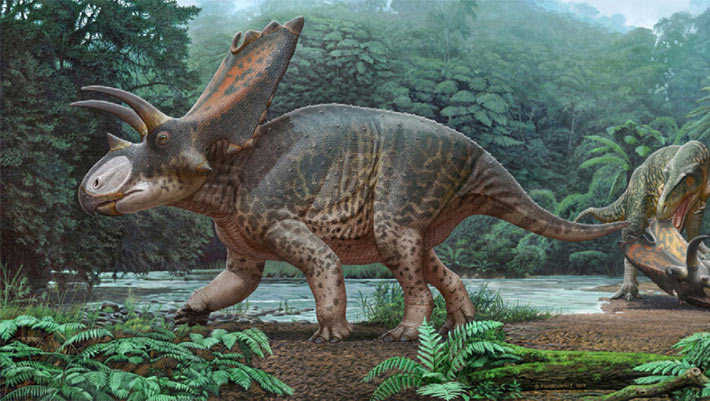A new genus and species of chasmosaurine ceratopsid dinosaur has been identified from a fossilized skull held in U.S. museums for several decades. The specimen had previously been classified as belonging to a different ceratopsid dinosaur genus, Pentaceratops.
Life reconstruction of Bisticeratops froeseorum. Image credit: Sergey Krasovskiy.
The new dinosaur species belonged to Chasmosaurinae, a subfamily of herbivorous ceratopsid dinosaurs known from the northern region of the ancient continent Laramidia.
Dubbed Bisticeratops froeseorum, it lived in what is now the United States during the Late Cretaceous epoch, approximately 74 million years ago.
Its nearly complete skull was collected in 1975 by a University of Arizona field party in the Bisti/De-na-zin Federal Wilderness area.
The fossil, about 1.75 m (5.7 feet) long, came from the upper part of the Farmington Member of the Kirtland Formation.
It has several pathologies — most likely bite marks made by a carnivorous tyrannosaurid dinosaur.
Holotype skull of Bisticeratops froeseorum: (A) right lateral view; (B) line drawing of the skull in right lateral view showing various cranial morphological features. Image credit: Dalman et al.
Bisticeratops froeseorum differs from other known chasmosaurine dinosaurs, especially from older species in the same geographic region.
“The phylogenetic analysis strongly supports the placement of Bisticeratops froeseorum in the subfamily Chasmosaurinae,” said Dr. Spencer Lucas and his colleagues from the New Mexico Museum of Natural History and Harrisburg University.
“Bisticeratops froeseorum is younger than Pentaceratops sternbergi by two million years, than Navajoceratops sullivani by one million years, than Terminocavus sealeyi by 750,000 years, and older than Sierraceratops turneri by one million years.”
“Bisticeratops froeseorum is missing the majority of the diagnostic frill,” they added.
“However, it can be differentiated from other chasmosaurines, especially from its close relative the Almond Formation chasmosaurine and its more distant relative Pentaceratops, on the basis of several cranial characters.”
“The recognition of Bisticeratops f

